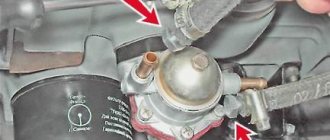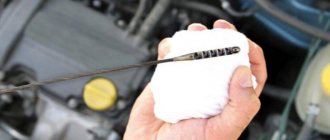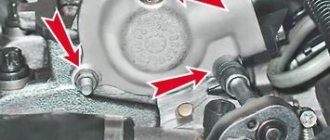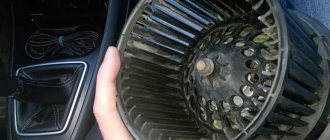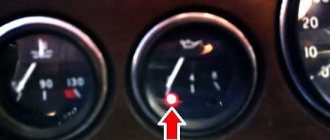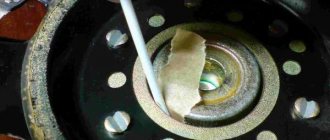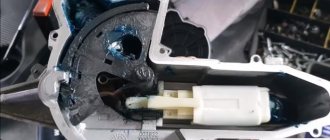The smell of gasoline in the car interior is extremely unpleasant. This applies to all cars, and the VAZ 2107 is no exception. The smell is harmful not only to the driver, but also to passengers. There are many reasons why your car smells like gasoline. Let's look at the most common ones and see if they can be eliminated on our own.
- The smell of gasoline in the interior of a fuel-injected car
Leaking gas line - Electric fuel pump problems
- Poor injector adjustment and other reasons
- Fuel line leakage
- Adjustment sequence
- Adjustment sequence
Why should a car's fuel system be sealed?
Currently, the VAZ 2107 car has been discontinued, so it has now become a domestic automobile classic. Despite this, a lot of people drive “Sevens” in our country. The tightness of the fuel system in these cars has always left much to be desired. This applies to both early carburetor “sevens” and later injection ones.
The tightness of the VAZ 2107 fuel system is the key to clean air in the cabin
Meanwhile, the fuel system of any car must be absolutely sealed, and here’s why:
- fuel consumption increases. It's simple: if the car smells like gasoline, it means gasoline is leaking from somewhere. And the larger the leak, the more often the car owner will have to refuel;
- risk of fire. If there is a high concentration of gasoline vapors in the cabin, the risk of fire increases significantly. One stray spark is enough and the interior will be engulfed in flames. And the driver will be very lucky if he survives;
- harm to health. When a person inhales gasoline vapors for a long time, this does not bode well for him. This may cause nausea and dizziness. In some cases, a person may lose consciousness. In addition, systematic inhalation of gasoline vapors can lead to the development of cancer.
Considering all of the above, if the smell of gasoline appears in the cabin, the driver must do everything possible to eliminate this problem, no matter how insignificant it may seem.
The smell of gasoline in the interior of a fuel-injected car
As mentioned above, the VAZ 2107 was produced in two versions: injection and carburetor. Both models periodically “delighted” their owners with unpleasant odors in the cabin. First, let's look at injection models.
Fuel line leaking
If the gas line in the carburetor “seven” for some reason begins to leak fuel, the appearance of a gasoline smell in the cabin is inevitable. Most often this happens for the following reasons:
- problem with the fuel check valve. It is located at the rear, behind the passenger seats. This valve was never reliable, and over time it began to leak gasoline. In addition, it may simply get stuck in the closed position. As a result, gasoline vapors will not be able to escape into the adsorber and will fill the interior of the Seven. The solution is obvious - clean or replace the check valve;
Due to a clogged check valve, the smell does not escape into the adsorber. - crack in the fuel tank. Tanks on later injection "sevens" often crack. This usually occurs due to mechanical damage: a strong blow or a deep scratch, which over time has rusted and began to leak gasoline. For whatever reason, a fuel leak starts, the tank will have to be either sealed or replaced. It all depends on the size of the crack and its location;
The smell of gasoline in the cabin often occurs due to a cracked gas tank. - problem with the hoses on the fine filter. On injection "sevens" these hoses are attached to the filter using very unreliable thin clamps that weaken over time. Fuel begins to leak, and the smell of gasoline appears in the cabin. The best solution is to replace the standard clamps with thicker ones. The width of the clamp must be at least 1 cm. You can purchase such clamps at any spare parts store.
Electric fuel pump problems
On the latest models of injection “sevens”, electric fuel pumps were installed. The main task of the pump is obvious: to supply fuel from the tank to the injector. At first glance, the appearance of an unpleasant odor in the cabin cannot be associated with a faulty pump, since this device itself is located in the fuel tank. However, there is a connection. The pump, like any other device, wears out over time. The most wear-out element in this device is the sealing gaskets. Also, we should not forget that the pump is cooled by the same gasoline that it supplies to the injector.
The smell of gasoline in the cabin sometimes occurs due to overheating of the fuel pump.
If the driver does not monitor the fuel level in the tank, the pump may begin to overheat, resulting in an unpleasant odor. And if the driver constantly uses low-quality gasoline, the coarse fuel filter may become completely unusable. As a result, the smell of an overheated fuel pump can reach the interior. Solution: remove the pump, replace the gaskets, replace the fuel filters and use only high-quality gasoline with the appropriate octane number.
Poor injector adjustment and other reasons
In some injection-powered "sevens" the smell of gasoline can be felt in the cabin immediately after the engine starts. It should be said right away that this is not always considered a malfunction. For example, on old “Sevens” the smell of gasoline often appears when the driver starts a cold engine in winter, in severe frost. If such a picture is observed, the driver should take into account these points:
- the sensor that takes the temperature from the engine transmits data to the electronic control unit of the “seven” that the engine is cold;
- the block, guided by these data, creates a rich fuel mixture, simultaneously increasing the starting speed of the engine, putting it in warm-up mode;
- Since the mixture is rich and the cylinders are cold, the fuel simply cannot burn completely in them. As a result, some of the gasoline ends up in the exhaust manifold, and the smell of this gasoline enters the cabin.
If the injector is working properly, the smell of gasoline will disappear as soon as the engine warms up. If this does not happen, then there is poor injector adjustment or engine problems. Here's what it could be:
- malfunctions in the ignition system;
- malfunctions in the injector mixture formation system;
- poor compression in the cylinders;
- oxygen sensor failure;
- clogging of one or more nozzles;
- air entering the injection system;
- The ECM sensor has failed.
The result in all of the above cases will be the same: incomplete combustion of fuel, followed by the release of its residues into the exhaust system and the appearance of a gasoline smell in the car interior.
Can the tank be damaged?
Unlike other cars, where the tank is located under the seat, the risk of damage to it on a Zhiguli increases significantly. After all, he is not protected by anything additional. This can also cause leaks and an unpleasant smell in the cabin that comes from the trunk.
Therefore, when transporting large loads, you need to ensure maximum safety of the tank (although in most cases it simply gets wrinkled). In the event of a breakdown, this element cannot be repaired and is replaced entirely. The use of sealant or cold welding cannot ensure complete safety.
The smell of gasoline in the interior of a carburetor car
The very first “sevens” were equipped only with carburetors. Due to problems with these devices, the smell of gasoline also appeared in the interior of the VAZ 2107.
Due to poor carburetor adjustment, a gasoline smell may appear in the cabin.
Let's consider typical malfunctions of carburetor "sevens", leading to the fact that the driver began to inhale a specific gasoline "aroma".
Fuel line leakage
Problems with various elements of the fuel line are the most common phenomenon in old “sevens”:
- gas tank leak. It was already mentioned above that in the new injection “sevens” the strength of gas tanks leaves much to be desired. In older carburetor models, the tanks were much stronger. However, the venerable age of these cars cannot be discounted. The tank, no matter how durable it is, begins to rust over time. And the older the carburetor “seven”, the higher the likelihood that the tank will rust through;
- fuel tank hoses. This is another vulnerable element of the fuel line. These hoses are located under the car. They are attached with clamps to the fuel line pipes. The clamps are thin and narrow. Over time, they weaken and the hoses begin to leak. As a result, fuel consumption increases, and the driver begins to breathe gasoline vapors;
- hoses on the valve for return flow of gasoline. This valve is located in the engine compartment, next to the carburetor. The return hose periodically experiences high pressure, which may one day cause it to crack and leak. Interestingly, the clamps holding the valve almost never loosen or leak.
The backflow valve on the “seven” has never been a particularly sealed device
Fuel pump malfunction
In carburetor “sevens”, mechanical rather than electric fuel pumps were installed.
On old carburetor “sevens” there are only mechanical fuel pumps
These pumps differed in design, but they had the same set of problems as electric pumps: early wear of the gaskets, associated with overheating due to low fuel levels and clogged filters . The solution is the same: replacing filters, seals and using high-quality gasoline.
Carburetor leak
There are several reasons why the carburetor in a VAZ 2107 begins to leak. But the result is always the same: the cabin smells of gasoline.
If the carburetor is poorly configured, the cabin will certainly smell of gasoline.
Here's why this happens:
- The carburetor on the “seven” could simply become clogged due to the use of low-quality gasoline. The solution is obvious: remove the carburetor and rinse it thoroughly in kerosene;
- There was a leak at the junction of the carburetor and the manifold. This is another common “disease” on old “sevens”. You should either tighten the corresponding clamp or install a new one;
- float is poorly adjusted. If the adjustment of the float chamber was carried out incorrectly, or for some reason went wrong, the chamber will begin to overflow. Excess gasoline may leak out. And the driver in the cabin will immediately feel it;
- leak through the lid. This is another result of poor carburetor adjustment, only gasoline does not flow through the float chamber, but directly through the cover. Usually this breakdown is accompanied by a violation of the tightness of the rubber seal located under the cover;
- The carburetor fitting was leaking. This part rarely breaks, but it does happen. There is only one solution here: purchasing and installing a new fitting. This part cannot be repaired.
In all of the above cases, the carburetor will have to be adjusted. Usually it all comes down to a simple idle adjustment, but this will be discussed below.
Mixture too rich
If the carburetor on a VAZ 2107 creates a too rich mixture, then the consequences will be the same as on the injection “seven”. The fuel will not have time to burn completely and will begin to enter the exhaust system. And the cabin smells of gasoline. Sooner or later, this situation will lead to the fact that the muffler on the “seven” will burn through, a thick layer of soot will appear on the pistons, and fuel consumption will increase significantly. And this is why a rich mixture arises:
- the air filter is clogged. Consequently, little air enters the carburetor and the mixture turns out rich. Solution: change the air filter;
If the VAZ 2107 air filter is clogged, the fuel mixture will be too rich - The air sensor has failed. As a result, the carburetor creates the mixture incorrectly. Solution: change the air sensor;
- The fuel pump is not working properly. Usually it creates too high pressure in the fuel line, which ultimately leads to a rich mixture. Solution: diagnose the fuel pump and adjust it;
- The throttle valve does not move well or is very dirty. As a rule, these two points are connected: the damper first becomes dirty, and then hardly moves. Depending on the position in which the valve is stuck, the mixture may be either too lean or too rich. The second option is more common. Solution: removing and flushing the carburetor.
Diagnosing problems on cars - what to pay attention to?
Diagnosis of a malfunction consists of checking the condition of all components that were discussed above and replacing faulty elements.
In this case, everything begins with a visual inspection, after which it is worth moving on to checking individual components - the fuel filter, carburetor, injector and others.
It is also worth considering that cars with a carburetor and an injector have their own nuances of searching for damage:
Carburetor cars VAZ 2101-2105/2106/2107.
As mentioned above, the weak point of the “classic” is the carburetor, the operation of which is based on a mechanical principle. Details about the carburetor
To avoid problems, it is recommended to periodically adjust the device and check it for serviceability.
In case of unprofessional adjustment, fuel overflows from the top, and its vapor enters the vehicle interior.
In injection cars, the problem of overflow is eliminated.
Diagnosing the problem is easy. When the engine is idling, the carburetor is dry and clearly performs its functions. But as soon as you add gas, fuel leaks out from under the gasket.
The reason is broken threads or poorly tightened bolts. There are situations when the carburetor leaks the intake pipe to which the supply hose is attached.
Also, on the “classic” there are often problems with the fuel pump, from under the membranes of which fuel leaks. To eliminate the problem, it is worth tightening all the bolts.
This category includes the popular today VAZ-2107, 2108, 2109, Niva (21213) and other models (including 2110, 21099).
In such cars, there may be a problem with the injector nozzle, which breaks off if there is a defect or improper use.
Problems often arise in the fuel line - in the area from the tank to the engine. For this reason, the first thing to start with is to inspect the fuel line. Once a leak is discovered, it should be repaired immediately.
How to solve a problem?
A new electric fuel pump gasket is required. It is very easy to replace it. First you need to relieve the pressure in the injector power system. To do this, you need to start the engine and remove the fuse for the pump while the engine is running. After a couple of seconds the car will stall on its own. Next, you need to open the trunk and use a 7 key to unscrew the submersible pump mounting bolts in order. It is a one-piece structure that combines a coarse filter, a gasoline level indicator, fuel lines, an anti-drip cup and a cover.
After unscrewing all eight bolts, you need to remove the pump by removing the wire plug. Be careful - when removing, the fuel level indicator may get stuck (it is slightly bent and has a float at the end).
Next you need to work with the gasket itself. It is necessary to remove and clean the area from dirt, if any. Then install the new one in the same way. Make sure that the element fits neatly into the tank studs. Then you need to put the pump back and tighten the bolts, connect the chip, fuse and try to start the engine. The smell of gasoline in the interior of the VAZ-2107 (injector) should disappear.
Helpful advice
When repairing the fuel system, you can perform preventive maintenance on the coarse filter. It is a polymer mesh and is located at the bottom of the anti-drip cup. The filter can be washed in acetone or any other solvent. Then clean with a hard brush and blow with compressed air. Well, the best option is to replace the mesh with a new one. The only problem is that it is often sold only complete with a pump, and it costs about a thousand rubles.
Injector adjustment
Adjusting the VAZ 2107 injector in a garage usually comes down to adjusting the idle air controls. This regulator is a miniature electric motor in which a small needle is installed. The purpose of the regulator is to receive signals from the control unit, supply air to the ramp and thereby maintain optimal idle speed of the “seven” engine. If any failure occurs in this system, the regulator should be checked.
Adjustment sequence
Before starting work, the VAZ 2107 engine must be allowed to cool. This is an important preparatory stage. This takes from forty minutes to an hour (it all depends on the time of year).
- Both terminals are removed from the battery. After this, the speed controller is unscrewed.
If this regulator does not operate correctly, stable idling is impossible. - The hole in which this regulator is located is thoroughly purged with compressed air.
- The regulator is disassembled, its main bushing is carefully inspected for scratches, cracks and other mechanical damage. If any are found, the regulator will have to be replaced. This device cannot be repaired.
- The second element that should be checked is the regulator needle. It should not have any, even the most minor, abrasions and wear. If there are such defects, the needle will have to be changed.
All the main elements of the regulator are visible - the needle, copper windings and guide bushing - The next step is to check the regulator windings using a multimeter. It's simple: the resistance of the windings should not be zero, but must correspond to the passport values (these values can be clarified in the car's operating instructions). If the windings are intact, the regulator is assembled and installed in place. The engine starts and idles. If the engine is running normally and there is no smell of gasoline in the cabin, the adjustment can be considered complete.
Video: how to change the idle air control on a VAZ 2107
A crack has appeared between the neck and the tank
The neck is securely welded to the tank. But under the influence of corrosion or as it ages, the weld may begin to delaminate, which leads to a crack. Naturally, gasoline begins to evaporate from the crack. The effect is especially noticeable immediately after refueling and continues as long as the tank is more than half full.
To get rid of the problem, you will either have to install a new gas tank or temporarily seal the gap with laundry soap. Sometimes after this procedure, drivers ride for several more years. Although the best solution is to solve the problem in other ways.
You can check not only the cooking area, but also the rubber tube that connects the neck to the body of the tank. The tightness of the rubber tube that connects these elements may also be compromised.
Adjusting the carburetor on a VAZ 2107
If the driver has an old carburetor “seven”, then to eliminate the smell of gasoline you will have to adjust the idle speed on the carburetor. To do this you will need a flathead screwdriver.
Adjustment sequence
- The engine starts at idle speed. After this, the quality screw on the carburetor is turned clockwise with a screwdriver until the crankshaft reaches maximum speed.
- After setting the maximum speed (they are determined by ear), use the same screwdriver to turn the screw responsible for the amount of mixture. It is necessary to achieve a situation in which the number of revolutions will be no more than 900 per minute (determined using a tachometer).
When adjusting idle speed, always adjust the quantity screw first, and then the quality screw - The final stage is the rotation of the screw, which is responsible for the quality of the mixture. This screw rotates clockwise until the number of revolutions reaches 780–800 per minute. If you managed to achieve this indicator, then the carburetor adjustment can be considered successful.
Video: adjusting carburetor idle speed
Checking the fuel line
As mentioned above, the smell of gasoline most often occurs due to leaks in the fuel line. Therefore, the driver must know the weak points of this design. When inspecting the fuel line, pay attention to the following:
- integrity of the fuel tank. To inspect it, it is best to drive the car into a pit and use a powerful flashlight. There should be no leaks, dents, scratches or other mechanical damage on the tank;
- checking the fuel line. The fuel line is a system of hoses and tubes through which fuel is supplied from the tank to the engine. Most of this system is located on the bottom of the car. Therefore, the driver must carefully check all connections, clamps and joints of this line for leaks;
All connections on the fuel line pipes should be carefully inspected at least once a month. - connections on the fine fuel filter. A pair of short tubes are connected to the filter. These tubes, in turn, are connected to hoses. As a result, eight connections arise at once, which very often begin to leak. Therefore, immediately after inspecting the line, you should check the connections on the fine filter;
The hoses on the “Seven” fine filter have never had good tightness - air filter. Its condition should also be checked, although it does not relate directly to the fuel line. It's simple: if the air filter is clogged, then even with a completely sealed fuel line you will not be able to get rid of the smell of gasoline, since due to a bad filter the fuel mixture will be too rich.
So, the smell of gasoline in the interior of the “Seven” can arise for a variety of reasons, many of which are not always obvious. However, the driver can eliminate the vast majority of these reasons on his own. All you need to do is simply follow the recommendations above.
Car alarm with feedback
How to catch an attacker in the act and protect the car from draining gasoline, three conditions are necessary:
- the car must have a car alarm with feedback installed;
- additional alarm functions will be required;
- after the alarm signal, it will be possible to get to the car in a short time (up to 5 minutes).
Most cars on the modern car market are already equipped with an additional option upon sale - a car alarm with feedback. This is a rather convenient security system that has the necessary functionality, compared to ordinary squealers, which only harm those around you.
Imagine that the whole yard is filled with many different cars, but which emit the same sound signals, for various reasons, depending on what they are tuned to:
- strong wind,
- the dog hit
- a car passed nearby, etc.
Who can say with a high degree of confidence that it was the alarm on his car that went off? So car owners have to jump up at every squeak of the “alarm” in the yard and peer intensely through the window to see if the lights on their car are flashing.
Against this background, feedback signaling is much more convenient. The only drawback when installing it on a classic is the lack of protection against gasoline drainage. The gas tank hatch does not have a factory lock on the classic, that is, access to the neck is practically open - remove the cap, insert the hose and drain the gasoline.
The installation of special lids with locks on the neck has already been discussed above. This is not at all effective in protecting against gasoline leakage. There are car owners who have lost up to five covers of different designs. Moreover, during such break-ins, not only the paint near the neck suffers, but also dents remain on the wing.

